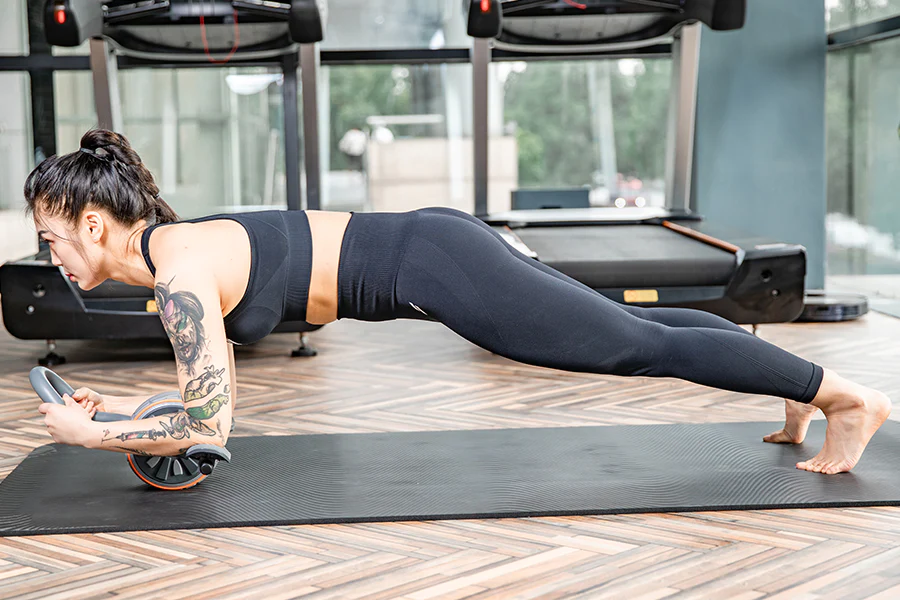Table of Contents
Exercise Daily – When you think of exercise, do you think of toning muscles? Chances are, you don’t. Most people think of cardio and strength training when it comes to getting in shape. But what about the abs? Abdominal muscles are just as important as any other muscle group, and they can be easily forgotten when we’re focusing on more prominent areas. That’s why it’s important to include abdominal exercises in your routine; not only will they help tone your lower body, but they will also help improve your posture. Here are the five best exercises to prevent diastasis recti:
The best exercises to prevent diastasis recti are abdominal focusing exercises. These daily exercises specifically target the abdominal muscles and help keep the abs toned and strong. There are a number of different abdominal focusing exercises, so find one that you enjoy and stick with it. Start out by doing a few sets of 10 repetitions, then gradually increase the number of repetitions as you become stronger.
Another good exercise to prevent diastasis recti is Pilates. Pilates is a great way to improve your flexibility and tone your muscles all at once. You can do Pilates at home or in a gym setting, so find a class that fits your schedule and make time for it!

What Causes Diastasis Recti?
There is no single cause of diastasis recti, but a variety of factors can contribute. These include childbirth, obesity, genetics, and age. Some people are more prone to developing diastasis recti after pregnancies or weight gain, while others may be more likely to experience it as they get older. Some of the best exercises to prevent diastasis recti include:
1. Pelvic floor strengthening: This exercise helps tighten the muscles in the pelvic floor, which can help reduce their ability to stretch. To do this exercise, lie down with your knees bent and feet flat on the ground (or on a bench), and lift your hips until your torso and thighs are off the ground. Hold for 10 seconds, then release. Repeat 10 times.
2. Kegel exercises: These exercises strengthen the muscles that control urination and bowel movements (the pelvic floor). To do these exercises, imagine you’re trying to stop the flow of urine or feces with your pelvic floor muscles. Hold for 5 seconds, then release. Do 20 repetitions per day.
3. Strengthening abdominal muscles: Abs are important for preventing diastasis recti because they help create a strong waistline and hold organs in place during childbirth; prenatal exercise is also linked with a decreased risk of diastasis recti later in life. To strengthen your abs, perform three sets of twenty abdominal crunches every day.

The 5 Best Exercises to Prevent Diastasis Recti
If you’re looking to prevent diastasis recti, incorporating these five exercises into your routine is a great place to start. Each exercise can help tighten your abdominal wall and reduce the risk of developing this common belly problem.
But be warned: these exercises are not for the faint of heart! They require some muscle effort and will make you feel as though you’re putting your abs through hell. But if you’re serious about preventing diastasis recti, then give these exercises a try.
1. Swiss Ball Crunch
Start by lying flat on your back on the ground with a Swiss ball placed at your feet. Dig your heels into the ball and lift your torso off the ground, extending your arms overhead while keeping your core tight. Hold this position for three seconds before returning to the starting position and repeating it 10 times.

2. Bicycle Crunches
Start in a seated position with both legs extended in front of you, bent at 90 degrees. Place palms on top of thighs for support and crunch forward until body forms an L-shape, then slowly return to starting position and repeat 10 times. You can also Adjust Your Own Back if you do not feel well.
 3. Russian Twist
3. Russian Twist
Lie facedown on the floor with legs straight out in front of you, shoulder-width apart, and hands behind head rest. Keeping abs engaged, gently curl upper body onto left elbow as far as possible before reversing movements and completing 10 reps on the right side.

4. Ab Wheel Rollouts
Obtain an ab wheel and position it so that the middle of the wheel is just below your navel. Plant feet firmly on the ground and lift the ab wheel off the ground, keeping your abs engaged the entire time. Slowly lower the ab wheel back to the ground, repeating 10 times.

5. Swiss Ball Crunches with Resistance Band
Start in a seated position with legs extended in front of you and feet flat on the floor. Place palms on top of thighs for support and slowly lean back until the body forms an L-shape. From here, grip one end of a resistance band and hold it in front of you, about shoulder-width apart. Crunch forward until body forms an L-shape again, then slowly return to starting position and repeat 10 times.

How Often Do the Exercises
There is no one-size-fits-all answer to this question, as the frequency of exercises will depend on your level of fitness, your body composition, and your goal. In general, you should perform progressive resistance training three times per week for optimal results. However, if you are new to exercise or find that your pain levels are high after each session, start with twice-weekly workouts and increase the frequency as your body becomes accustomed to the routine. Also check the 5 Best Bicep Exercises With Bands.
It is also important to keep in mind that some people may only need to do certain exercises intermittently. for example, a person who has mild diastasis recti might only need to perform isolation exercises once per week. As always, consult with a doctor or registered physical therapist before starting an exercise program if you have any health concerns.
The Causes of Diastasis Recti
Diastasis rectus is a common physical condition in which the separation of the abdominal muscles occurs. The condition can occur during pregnancy, childbirth, weightlifting, and other strenuous activities. Many cases improve with proper exercise and lifestyle changes, but others may require surgery.
The exact cause of diastasis recti is still unknown, but it appears to be associated with poor muscle function and imbalance. Certain factors that may contribute to diastasis recti include:
Pregnancy: Pregnancy can cause increased pressure on the pelvic floor and surrounding muscles, leading to the separation of these tissues.
Childbirth: During childbirth, extensive muscle contractions occur along the entire length of the gastrointestinal (GI) tract. This can lead to the separation of the muscles along the tract.
Weightlifting: Heavy weightlifting can also lead to diastasis recti by stretching or tearing tissues in the abdominal area.
Basic Exercises to Prevent Diastasis Recti
Diastasis recti, or separation of the rectus abdominal muscles, is a common problem and can cause pain, discomfort, and decreased fitness. The exercises in this article can help prevent diastasis recti and improve your fitness.
To prevent diastasis recti, start by stretching your abdominal muscles regularly. To do this, perform a few sets of repetitions of the following stretches. Sit on the floor with legs bent so that feet are flat on the ground and arms extended straight out to the side. Inhale as you lift your torso off the floor; exhale as you lower it back down. Keep your spine neutral (no leaning) throughout the stretch. Hold for 3-5 seconds each time.
Bicycle crunch: Lie flat on your back with feet flat on the ground and shoulder-width apart. Place hands behind your head and raise your torso off the floor while keeping your abs contracted. Dig your heels into the ground as you crunch up towards the sky; slowly lower back to starting position. Do 20 reps per side twice a day
Crab walk: Start in a standing position with feet hip-width apart and shoulders pulled down towards hips. Bend knees slightly and lean forward at the waist until hands are just above toes. Keeping core engaged, slowly walk forward until thighs are parallel to the ground then quickly return to the start position
The Advanced Exercises to Prevent Diastasis Recti
1. Diastasis recti is a condition in which the tissues that make up the wall of the uterus (the myometrium) are separated from each other. This can happen as a result of childbirth, advanced age, obesity, or chronic positions that put stress on the abdomen (such as being in a lotus position).
2. The best exercises to prevent diastasis recti are abdominal floor workouts. These exercises work the abdominal muscles and help to restore the integrity of the myometrium. There are several types of abdominal floor workouts you can do:
a. Pilates reformer: Lie face down on a reformer with your legs straight and arms at your sides. Keep your head and shoulders off the pad and use your abs to push yourself up and down for 10 seconds each time. Do four sets.
b. Stability ball ab work: lie on your back with a stability ball under your chest, legs bent, feet flat on the floor. Keep your core engaged and your chin drew toward your chest. Lift one leg up so that it’s partially off the ground and then lower it back to the floor without letting go of the ball. (Do three sets.)
c. Band ab work: attaching two comfortable bands around an appropriate tree, position yourself so that both knees are bent with feet flat on the ground and abs pulled in towards the spine. (Do three sets).
3. You can also improve diastasis recti by keeping your body hydrated. Drink plenty of water, avoid caffeine and alcohol, and eat foods that are low in fat and high in fiber.
4. Finally, if you experience diastasis recti symptoms, speak with your doctor. He or she can recommend the best exercises and treatments to prevent this condition from developing further. Check the 5 Best Dumbbell Bicep Exercises for Mass.
Conclusion
As we get older, the ligaments that hold our abdominal wall together become less elastic. This can cause the abdominal wall to pull apart, or “diastasis recti.” Diastasis recti occur when the separation between the two sides of the muscle becomes too wide and can lead to pain in your lower belly and back. Fortunately, there are a variety of exercises you can do to prevent diastasis recti from developing and worsening over time. Try some of these out for a routine that will help keep your abs strong!





